Application of Australian Accounting Standards on Asset Impairment
VerifiedAdded on 2023/06/05
|5
|1107
|51
Report
AI Summary
This report delves into the intricacies of asset impairment as defined by Australian Accounting Standards (AASB 136) and International Accounting Standards 36. It elucidates the factors contributing to asset impairment, such as technological advancements and economic shifts, emphasizing the critical role of the cost model in determining impairment losses. The report contrasts the fair value model for investment assets with the revaluation model for assets used in production, highlighting how these models affect impairment recognition. A detailed calculation example illustrates the process of determining impairment loss, differentiating between assets held for use and those held for disposal. Furthermore, the report discusses the guidelines set by the Australian Securities and Investments Commission (ASIC) for estimating recoverable amounts and the accounting treatment of impairment losses, ensuring that they are accurately reflected in the income and profit or loss account, without affecting cash flow. References to relevant academic literature are provided to support the analysis.
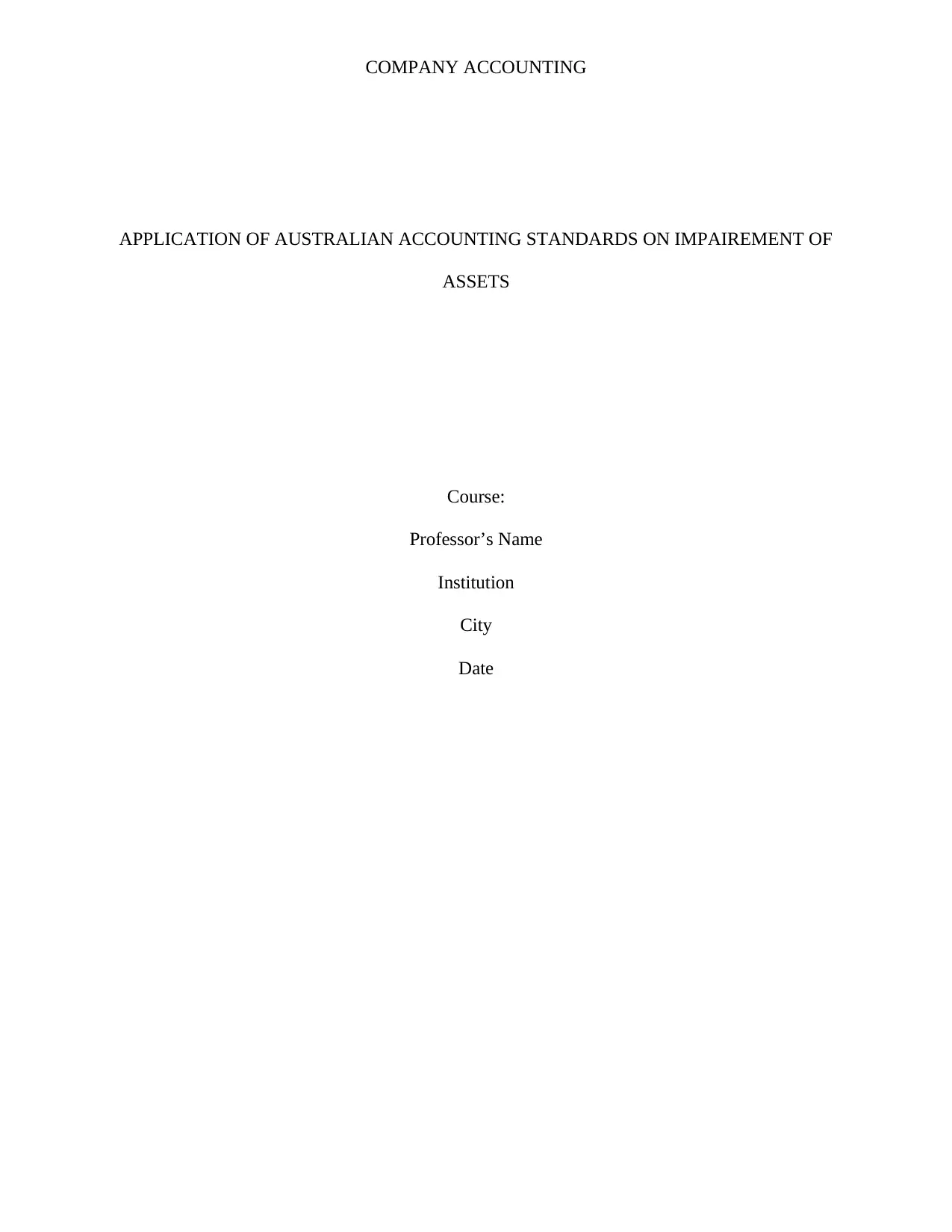
COMPANY ACCOUNTING
APPLICATION OF AUSTRALIAN ACCOUNTING STANDARDS ON IMPAIREMENT OF
ASSETS
Course:
Professor’s Name
Institution
City
Date
APPLICATION OF AUSTRALIAN ACCOUNTING STANDARDS ON IMPAIREMENT OF
ASSETS
Course:
Professor’s Name
Institution
City
Date
Paraphrase This Document
Need a fresh take? Get an instant paraphrase of this document with our AI Paraphraser
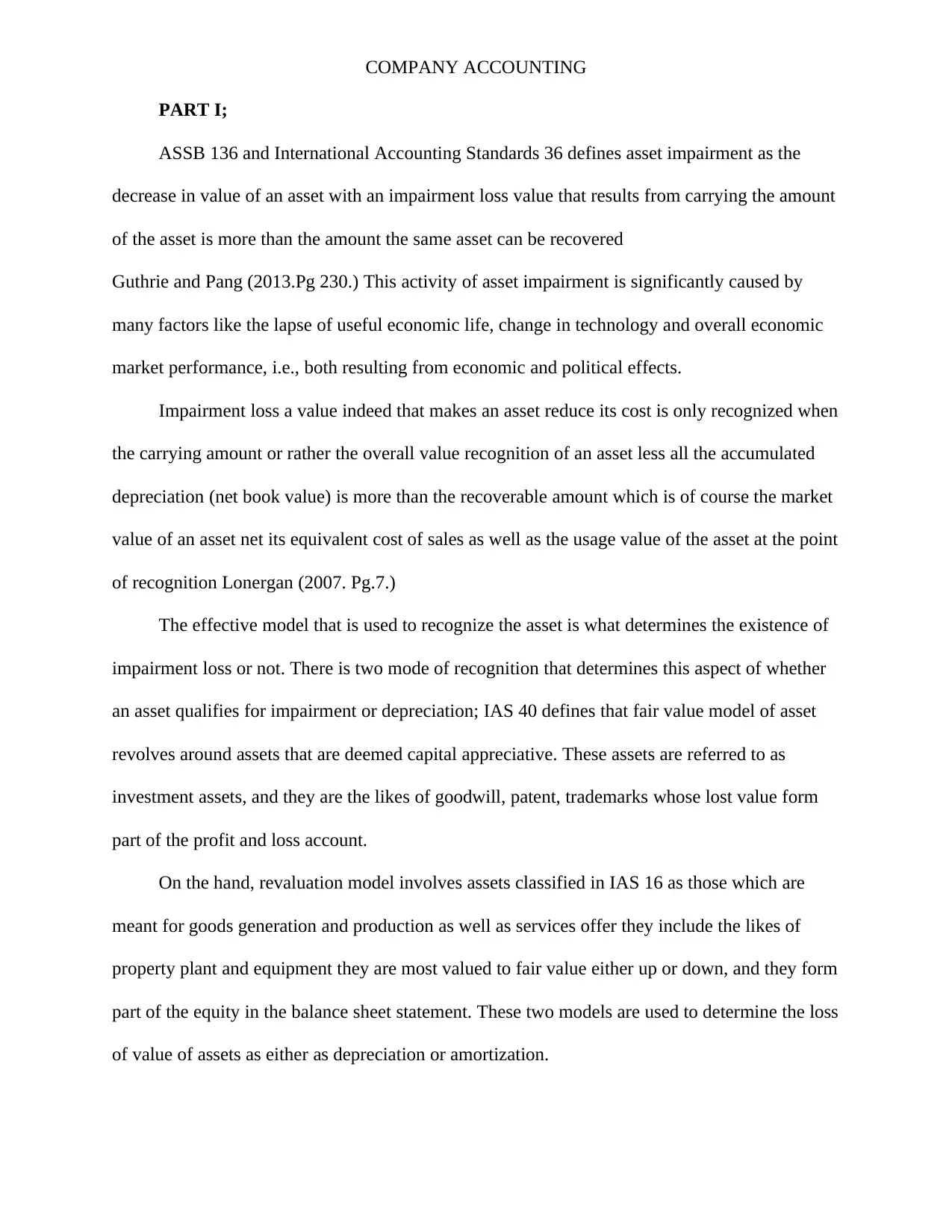
COMPANY ACCOUNTING
PART I;
ASSB 136 and International Accounting Standards 36 defines asset impairment as the
decrease in value of an asset with an impairment loss value that results from carrying the amount
of the asset is more than the amount the same asset can be recovered
Guthrie and Pang (2013.Pg 230.) This activity of asset impairment is significantly caused by
many factors like the lapse of useful economic life, change in technology and overall economic
market performance, i.e., both resulting from economic and political effects.
Impairment loss a value indeed that makes an asset reduce its cost is only recognized when
the carrying amount or rather the overall value recognition of an asset less all the accumulated
depreciation (net book value) is more than the recoverable amount which is of course the market
value of an asset net its equivalent cost of sales as well as the usage value of the asset at the point
of recognition Lonergan (2007. Pg.7.)
The effective model that is used to recognize the asset is what determines the existence of
impairment loss or not. There is two mode of recognition that determines this aspect of whether
an asset qualifies for impairment or depreciation; IAS 40 defines that fair value model of asset
revolves around assets that are deemed capital appreciative. These assets are referred to as
investment assets, and they are the likes of goodwill, patent, trademarks whose lost value form
part of the profit and loss account.
On the hand, revaluation model involves assets classified in IAS 16 as those which are
meant for goods generation and production as well as services offer they include the likes of
property plant and equipment they are most valued to fair value either up or down, and they form
part of the equity in the balance sheet statement. These two models are used to determine the loss
of value of assets as either as depreciation or amortization.
PART I;
ASSB 136 and International Accounting Standards 36 defines asset impairment as the
decrease in value of an asset with an impairment loss value that results from carrying the amount
of the asset is more than the amount the same asset can be recovered
Guthrie and Pang (2013.Pg 230.) This activity of asset impairment is significantly caused by
many factors like the lapse of useful economic life, change in technology and overall economic
market performance, i.e., both resulting from economic and political effects.
Impairment loss a value indeed that makes an asset reduce its cost is only recognized when
the carrying amount or rather the overall value recognition of an asset less all the accumulated
depreciation (net book value) is more than the recoverable amount which is of course the market
value of an asset net its equivalent cost of sales as well as the usage value of the asset at the point
of recognition Lonergan (2007. Pg.7.)
The effective model that is used to recognize the asset is what determines the existence of
impairment loss or not. There is two mode of recognition that determines this aspect of whether
an asset qualifies for impairment or depreciation; IAS 40 defines that fair value model of asset
revolves around assets that are deemed capital appreciative. These assets are referred to as
investment assets, and they are the likes of goodwill, patent, trademarks whose lost value form
part of the profit and loss account.
On the hand, revaluation model involves assets classified in IAS 16 as those which are
meant for goods generation and production as well as services offer they include the likes of
property plant and equipment they are most valued to fair value either up or down, and they form
part of the equity in the balance sheet statement. These two models are used to determine the loss
of value of assets as either as depreciation or amortization.
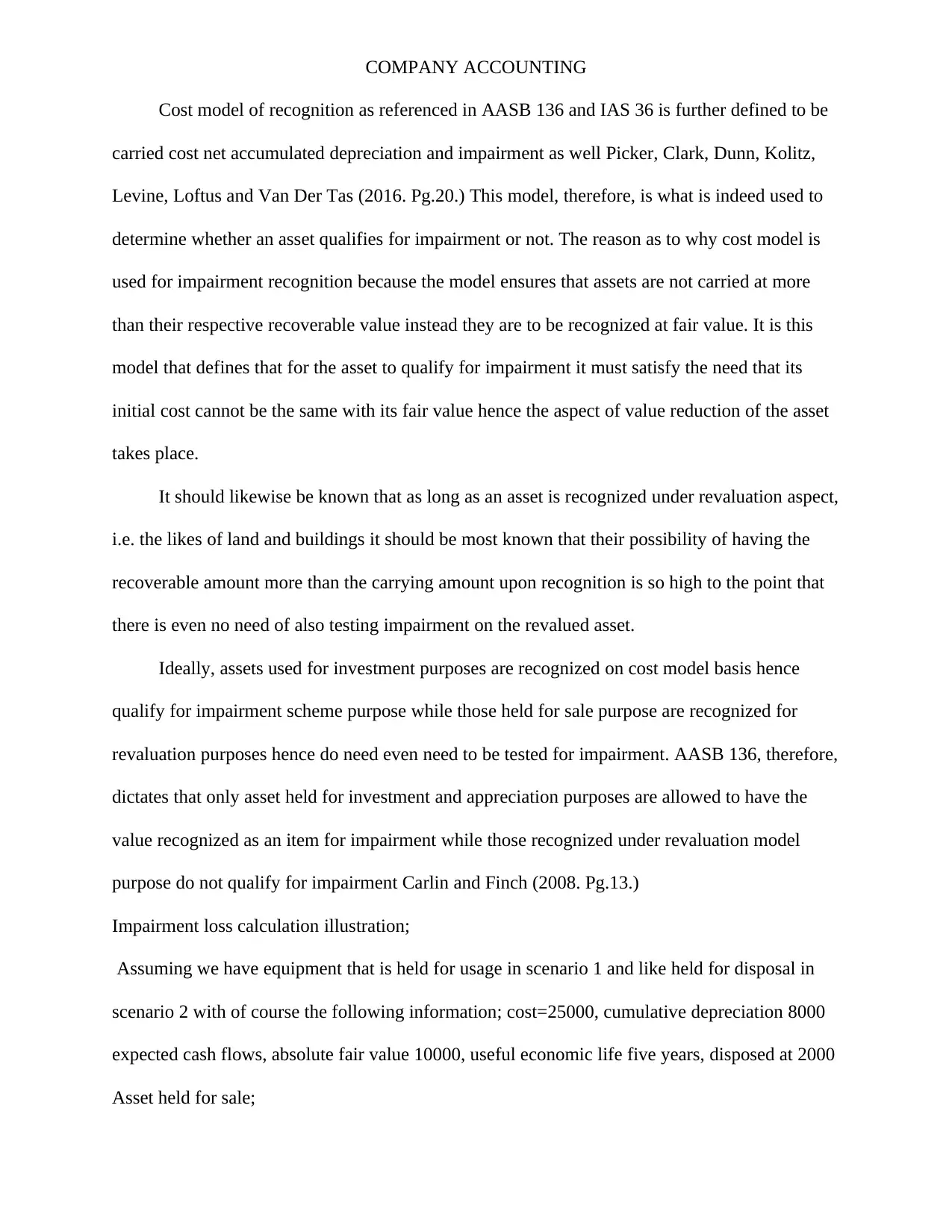
COMPANY ACCOUNTING
Cost model of recognition as referenced in AASB 136 and IAS 36 is further defined to be
carried cost net accumulated depreciation and impairment as well Picker, Clark, Dunn, Kolitz,
Levine, Loftus and Van Der Tas (2016. Pg.20.) This model, therefore, is what is indeed used to
determine whether an asset qualifies for impairment or not. The reason as to why cost model is
used for impairment recognition because the model ensures that assets are not carried at more
than their respective recoverable value instead they are to be recognized at fair value. It is this
model that defines that for the asset to qualify for impairment it must satisfy the need that its
initial cost cannot be the same with its fair value hence the aspect of value reduction of the asset
takes place.
It should likewise be known that as long as an asset is recognized under revaluation aspect,
i.e. the likes of land and buildings it should be most known that their possibility of having the
recoverable amount more than the carrying amount upon recognition is so high to the point that
there is even no need of also testing impairment on the revalued asset.
Ideally, assets used for investment purposes are recognized on cost model basis hence
qualify for impairment scheme purpose while those held for sale purpose are recognized for
revaluation purposes hence do need even need to be tested for impairment. AASB 136, therefore,
dictates that only asset held for investment and appreciation purposes are allowed to have the
value recognized as an item for impairment while those recognized under revaluation model
purpose do not qualify for impairment Carlin and Finch (2008. Pg.13.)
Impairment loss calculation illustration;
Assuming we have equipment that is held for usage in scenario 1 and like held for disposal in
scenario 2 with of course the following information; cost=25000, cumulative depreciation 8000
expected cash flows, absolute fair value 10000, useful economic life five years, disposed at 2000
Asset held for sale;
Cost model of recognition as referenced in AASB 136 and IAS 36 is further defined to be
carried cost net accumulated depreciation and impairment as well Picker, Clark, Dunn, Kolitz,
Levine, Loftus and Van Der Tas (2016. Pg.20.) This model, therefore, is what is indeed used to
determine whether an asset qualifies for impairment or not. The reason as to why cost model is
used for impairment recognition because the model ensures that assets are not carried at more
than their respective recoverable value instead they are to be recognized at fair value. It is this
model that defines that for the asset to qualify for impairment it must satisfy the need that its
initial cost cannot be the same with its fair value hence the aspect of value reduction of the asset
takes place.
It should likewise be known that as long as an asset is recognized under revaluation aspect,
i.e. the likes of land and buildings it should be most known that their possibility of having the
recoverable amount more than the carrying amount upon recognition is so high to the point that
there is even no need of also testing impairment on the revalued asset.
Ideally, assets used for investment purposes are recognized on cost model basis hence
qualify for impairment scheme purpose while those held for sale purpose are recognized for
revaluation purposes hence do need even need to be tested for impairment. AASB 136, therefore,
dictates that only asset held for investment and appreciation purposes are allowed to have the
value recognized as an item for impairment while those recognized under revaluation model
purpose do not qualify for impairment Carlin and Finch (2008. Pg.13.)
Impairment loss calculation illustration;
Assuming we have equipment that is held for usage in scenario 1 and like held for disposal in
scenario 2 with of course the following information; cost=25000, cumulative depreciation 8000
expected cash flows, absolute fair value 10000, useful economic life five years, disposed at 2000
Asset held for sale;
⊘ This is a preview!⊘
Do you want full access?
Subscribe today to unlock all pages.

Trusted by 1+ million students worldwide
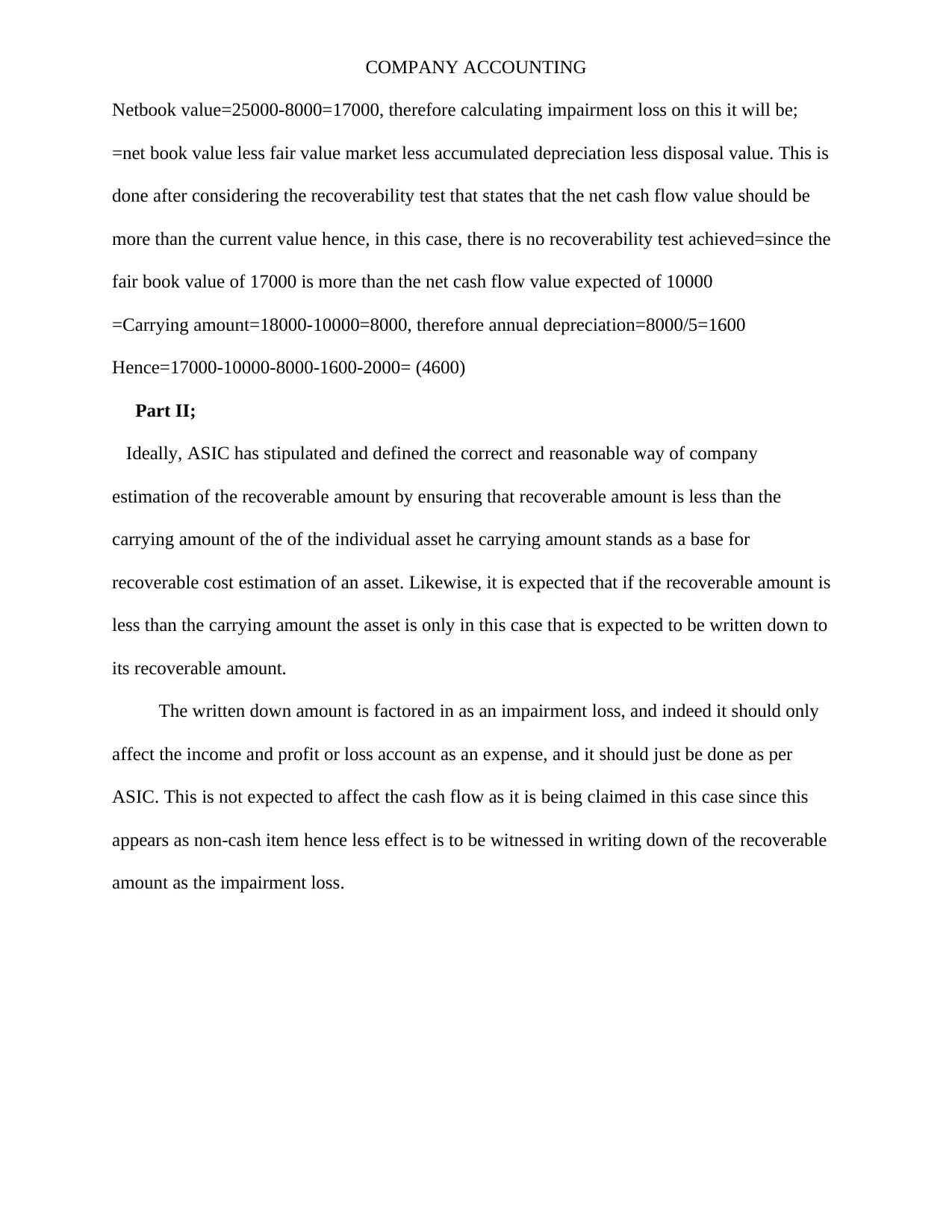
COMPANY ACCOUNTING
Netbook value=25000-8000=17000, therefore calculating impairment loss on this it will be;
=net book value less fair value market less accumulated depreciation less disposal value. This is
done after considering the recoverability test that states that the net cash flow value should be
more than the current value hence, in this case, there is no recoverability test achieved=since the
fair book value of 17000 is more than the net cash flow value expected of 10000
=Carrying amount=18000-10000=8000, therefore annual depreciation=8000/5=1600
Hence=17000-10000-8000-1600-2000= (4600)
Part II;
Ideally, ASIC has stipulated and defined the correct and reasonable way of company
estimation of the recoverable amount by ensuring that recoverable amount is less than the
carrying amount of the of the individual asset he carrying amount stands as a base for
recoverable cost estimation of an asset. Likewise, it is expected that if the recoverable amount is
less than the carrying amount the asset is only in this case that is expected to be written down to
its recoverable amount.
The written down amount is factored in as an impairment loss, and indeed it should only
affect the income and profit or loss account as an expense, and it should just be done as per
ASIC. This is not expected to affect the cash flow as it is being claimed in this case since this
appears as non-cash item hence less effect is to be witnessed in writing down of the recoverable
amount as the impairment loss.
Netbook value=25000-8000=17000, therefore calculating impairment loss on this it will be;
=net book value less fair value market less accumulated depreciation less disposal value. This is
done after considering the recoverability test that states that the net cash flow value should be
more than the current value hence, in this case, there is no recoverability test achieved=since the
fair book value of 17000 is more than the net cash flow value expected of 10000
=Carrying amount=18000-10000=8000, therefore annual depreciation=8000/5=1600
Hence=17000-10000-8000-1600-2000= (4600)
Part II;
Ideally, ASIC has stipulated and defined the correct and reasonable way of company
estimation of the recoverable amount by ensuring that recoverable amount is less than the
carrying amount of the of the individual asset he carrying amount stands as a base for
recoverable cost estimation of an asset. Likewise, it is expected that if the recoverable amount is
less than the carrying amount the asset is only in this case that is expected to be written down to
its recoverable amount.
The written down amount is factored in as an impairment loss, and indeed it should only
affect the income and profit or loss account as an expense, and it should just be done as per
ASIC. This is not expected to affect the cash flow as it is being claimed in this case since this
appears as non-cash item hence less effect is to be witnessed in writing down of the recoverable
amount as the impairment loss.
Paraphrase This Document
Need a fresh take? Get an instant paraphrase of this document with our AI Paraphraser
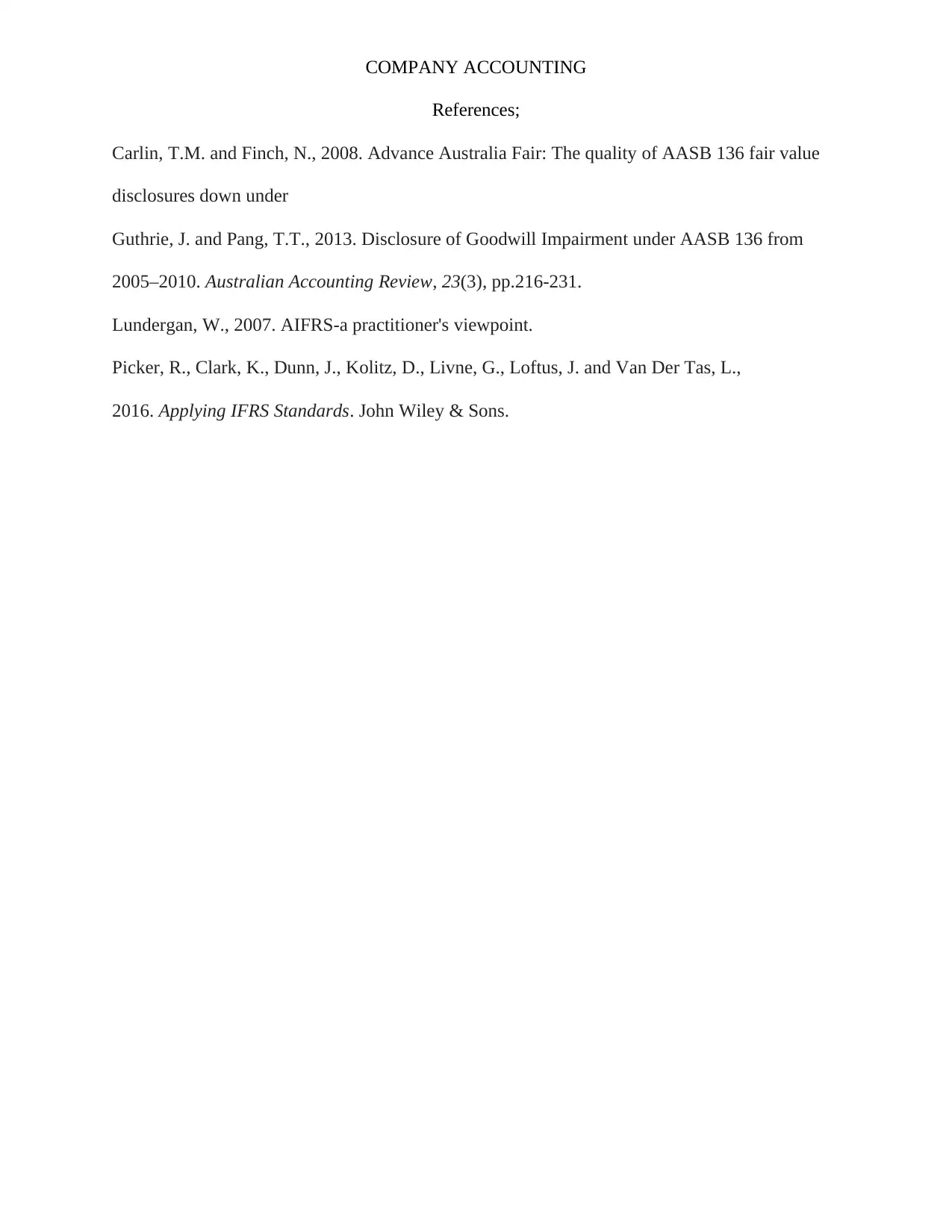
COMPANY ACCOUNTING
References;
Carlin, T.M. and Finch, N., 2008. Advance Australia Fair: The quality of AASB 136 fair value
disclosures down under
Guthrie, J. and Pang, T.T., 2013. Disclosure of Goodwill Impairment under AASB 136 from
2005–2010. Australian Accounting Review, 23(3), pp.216-231.
Lundergan, W., 2007. AIFRS-a practitioner's viewpoint.
Picker, R., Clark, K., Dunn, J., Kolitz, D., Livne, G., Loftus, J. and Van Der Tas, L.,
2016. Applying IFRS Standards. John Wiley & Sons.
References;
Carlin, T.M. and Finch, N., 2008. Advance Australia Fair: The quality of AASB 136 fair value
disclosures down under
Guthrie, J. and Pang, T.T., 2013. Disclosure of Goodwill Impairment under AASB 136 from
2005–2010. Australian Accounting Review, 23(3), pp.216-231.
Lundergan, W., 2007. AIFRS-a practitioner's viewpoint.
Picker, R., Clark, K., Dunn, J., Kolitz, D., Livne, G., Loftus, J. and Van Der Tas, L.,
2016. Applying IFRS Standards. John Wiley & Sons.
1 out of 5
Related Documents
Your All-in-One AI-Powered Toolkit for Academic Success.
+13062052269
info@desklib.com
Available 24*7 on WhatsApp / Email
![[object Object]](/_next/static/media/star-bottom.7253800d.svg)
Unlock your academic potential
Copyright © 2020–2025 A2Z Services. All Rights Reserved. Developed and managed by ZUCOL.




